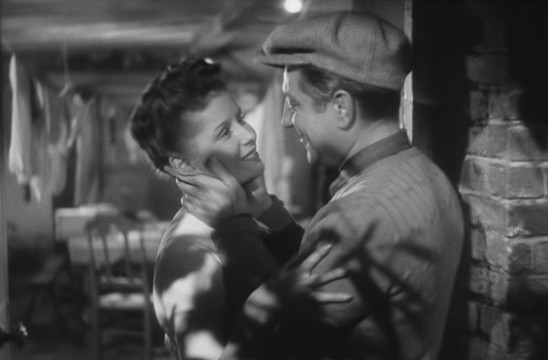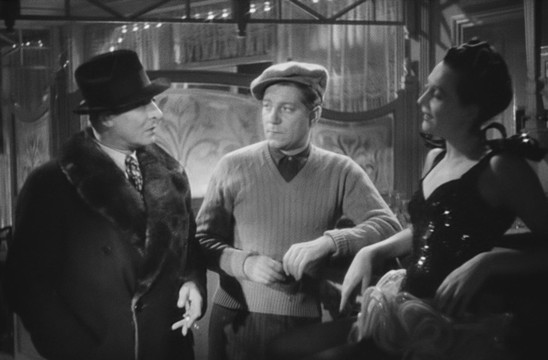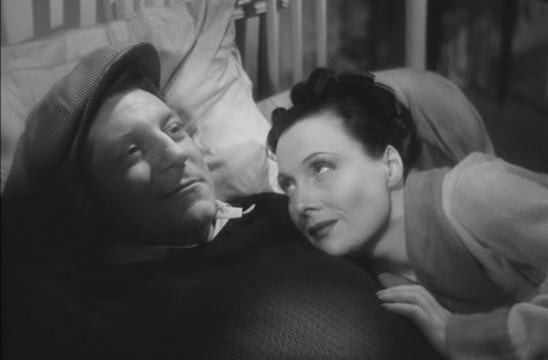Alongside our upcoming release of Marcel Carn’s Le Jour se leve on Friday 3rd October, we’ve been working with Ben McCann, Associate Professor in French Studies at the University of Adelaide, and author of a new French Film Guide published by I. B. Tauris, to further the reach of this historic reissue. Below, Ben writes about Le Jour se leve’s fascinating history, and why for him it’s this film of Carn’s that retains such a singular appeal.

Why did you decide to write a book about this particular film?
I first saw Le Jour se leve in my early twenties, whilst I was really discovering 1930’s French cinema, and seeking out these exciting classics for the first time. I had seen a couple of Carn’s earlier films, but nothing really prepared me for the monochrome beauty and the structural daring of Le Jour se leve. Its one of those films that plays out like a dream – perhaps the whole thing is in fact a kind of fever dream for Francois (Jean Gabin) as he lies in wait for his fate throughout the film – and I just loved the woozy verbal and visual memories the film conjures up. I’ve always admired the actor Jules Berry too (here, he plays the wonderfully oleaginous Valentin), and the way he uses body language to express a whole range of thoughts and sentiments. When I was approached to write a book about the film, I jumped at the chance to revisit it, rewatch it, and find new things to say.
Why did the Vichy government ban footage from original 1939 film?
The censors at the Vichy Department of Information – who had earlier called upon French directors to make healthy and optimistic films – identified fifty-six films as difficult, painful, derisory, depressing, morbid, and immoral. As might be expected, films like Le Jour se leve, as well as Carn’s earlier Hotel du Nord and Le Quai des brumes, were deemed demoralising and defeatist, and screenings of them were severely restricted. Another direct intervention from the censor was to remove the shot of the naked Arletty washing herself in the shower as Francois enters her apartment. To see the shot of a naked woman in late-30’s French cinema was unheard of, so the censors stepped in.

The original film was thought lost forever following its release but discovered again in 1950. What is the story behind that?
In 1946, Hollywood bought the rights to the film for their own version, The Long Night with Henry Fonda in the Gabin role, which was released in 1947 to box office failure and critical apathy. One of Hollywood’s practices at this time was to purchase the rights to original films, then take them out of distribution and destroy them. In London, the National Film Library was only allowed to hold a copy of Le Jour se leve on the strict proviso that it wouldn’t be shown publicly until permission was given by the new rightsholder, RKO.
The beginning of Le Jour se leve’s flourishing post-war acclaim was due in no small part to the French film critic Andre Bazin, who resurrected the film from widespread neglect and RKO’s suppression’s in his acclaimed Cine-club analysis, first distributed to film clubs in 1947 and published more widely in 1950. Part of that analysis was entitled Le Decor est un acteur / The Decor is an Actor, in which Bazin argued that the decor in Le Jour se leve possessed both a dramatic function and a decorative function, and concluded that the film possessed the ideal qualities of a cinematic paradise lost.
The film has been described as a classic in French poetic realism. Can you expand on why it has achieved this iconic status?
By 1939, Marcel Carn had become the leading standard bearer of the French Poetic Realist aesthetic. This film style combined romantic-fatalist narratives with claustrophobic environments and an accentuated mise-en-scene, and was a strong pre-cursor to American film noir. Le Jour se leve was one of the first films to employ a complex narrative syntax, full of the flashbacks, ellipses and symbolic objects that influenced Orson Welles, John Huston and Howard Hawks, but also young French directors like Jean-Pierre Melville, Jules Dassin and Jacques Becker, who borrowed Carn’s interleaving of the visual and the psychological to create similar narratives of despair and gloom. Straddling the divide between popular and auteur, Le Jour se leve expertly fits the definition of classical French cinema, with its accentuated visual style, poetic scripts, star actors, and elegant deployment of framing, editing, and camerawork.

Can you tell us where and who Carn might have drawn influence from to make this film?
Le Jour se leve is clearly influenced by the austere visual style of German Expressionists F. W. Murnau and Fritz Lang, while its recurring urban iconography and characters types recalled Carn’s early mentors Ren Clair and Jacques Feyder. Carn was a film critic before he became a director, so he would obviously have seen lots of films with different narrative and visual styles. He also wrote a series of impassioned articles that called upon French filmmakers of the early 1930’s to create a more democratic cinema that combined populism and underlying social comment to celebrate and ennoble the working-class. In many ways, Le Jour se leve is the culmination of that discussion.
Did Carn always have Jean Gabin in mind to play his working class hero Francois?
Carn was all set to film La Rue des vertus in 1939, which had been written expressly for Jean Gabin, but was bowled over by the narrative possibilities of Le Jour se leve. Gabin, Arletty and Jules Berry had already been contracted to the initial film, and so the transition from one project to another was relatively fluid. Carn had already worked with Gabin on Le Quai des brumes in 1938, so they were good friends, and responsive to each others professionalism. They’d also work again in together in the 1950’s, so there was clearly friendship and respect there throughout.
We hear that Jean-Pierre Jeunet and Lukas Moodyson are big fans of Carn. Why do you think he has entered the consciousness of contemporary European cinema?
Partly because the kinds of films Carn made have not really been made in Europe for many years, and so I think there is a sort of nostalgia there for the nuts-and-bolts filmmaking that came so naturally to Carn and his contemporaries. I also think his approach to filmmaking – professional, meticulous, harmonious never really goes out of fashion. Jeunet’s early films contain lots of little references and winks to Carn, so there is a sense that these directors are perhaps still in love with both the old-fashioned nature of Carn’s films, but also their modern, sophisticated elegance. Carn also had a great love of Paris its buildings, its people and Jeunet’s Amelie is a follow-on from that.

Do you have a favourite moment in the film?
I love the greenhouse scene, with Francoise and Francois. Its perhaps the most romantic in Carn’s entire oeuvre. Francois (complete with subtle lighting on his face, immaculately coiffed hair, and cloth cap) recounts his history of bad luck. Francoise’s role throughout this monologue is to stay silent and return his gaze, although her glistening lips and pale face, coupled with her flowery dress, continue to bolster her role as Francois’s object of desire. Her gaze is also one of empathy, of understanding, and not just one of restless physical yearning. Francois then delivers the quintessential Carn/Gabin/Jacques Prevert speech:
“You know when you’re waiting for a tram and its pouring with rain the tram doesn’t stop Ding! Full up. So you wait for the next one, Ding, ding! Full up, full up. The trams all go by Ding! And you stay there, you wait, But now you’re with me, everything’s going to be different…”
There’s a bittersweet melancholy and a stoic resignation here, and the sentiments voiced by Francois undaunted optimism, romantic faith exemplify not only Le Jour se leves inner workings, but the entire tone and style of French Poetic Realism.
Thank you, Ben!
To read more about Ben’s book, click here. To read about booking the film, visit our film page.

